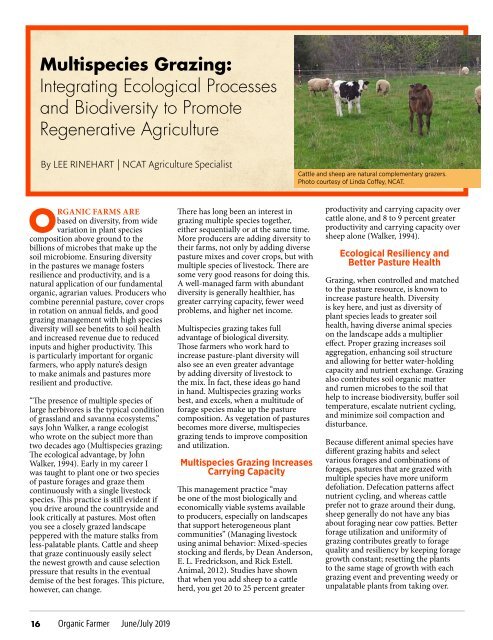Organic Farmer June 2019
Create successful ePaper yourself
Turn your PDF publications into a flip-book with our unique Google optimized e-Paper software.
Multispecies Grazing:<br />
Integrating Ecological Processes<br />
and Biodiversity to Promote<br />
Regenerative Agriculture<br />
By LEE RINEHART | NCAT Agriculture Specialist<br />
Cattle and sheep are natural complementary grazers.<br />
Photo courtesy of Linda Coffey, NCAT.<br />
ORGANIC FARMS ARE<br />
based on diversity, from wide<br />
variation in plant species<br />
composition above ground to the<br />
billions of microbes that make up the<br />
soil microbiome. Ensuring diversity<br />
in the pastures we manage fosters<br />
resilience and productivity, and is a<br />
natural application of our fundamental<br />
organic, agrarian values. Producers who<br />
combine perennial pasture, cover crops<br />
in rotation on annual fields, and good<br />
grazing management with high species<br />
diversity will see benefits to soil health<br />
and increased revenue due to reduced<br />
inputs and higher productivity. This<br />
is particularly important for organic<br />
farmers, who apply nature’s design<br />
to make animals and pastures more<br />
resilient and productive.<br />
“The presence of multiple species of<br />
large herbivores is the typical condition<br />
of grassland and savanna ecosystems,”<br />
says John Walker, a range ecologist<br />
who wrote on the subject more than<br />
two decades ago (Multispecies grazing:<br />
The ecological advantage, by John<br />
Walker, 1994). Early in my career I<br />
was taught to plant one or two species<br />
of pasture forages and graze them<br />
continuously with a single livestock<br />
species. This practice is still evident if<br />
you drive around the countryside and<br />
look critically at pastures. Most often<br />
you see a closely grazed landscape<br />
peppered with the mature stalks from<br />
less-palatable plants. Cattle and sheep<br />
that graze continuously easily select<br />
the newest growth and cause selection<br />
pressure that results in the eventual<br />
demise of the best forages. This picture,<br />
however, can change.<br />
There has long been an interest in<br />
grazing multiple species together,<br />
either sequentially or at the same time.<br />
More producers are adding diversity to<br />
their farms, not only by adding diverse<br />
pasture mixes and cover crops, but with<br />
multiple species of livestock. There are<br />
some very good reasons for doing this.<br />
A well-managed farm with abundant<br />
diversity is generally healthier, has<br />
greater carrying capacity, fewer weed<br />
problems, and higher net income.<br />
Multispecies grazing takes full<br />
advantage of biological diversity.<br />
Those farmers who work hard to<br />
increase pasture-plant diversity will<br />
also see an even greater advantage<br />
by adding diversity of livestock to<br />
the mix. In fact, these ideas go hand<br />
in hand. Multispecies grazing works<br />
best, and excels, when a multitude of<br />
forage species make up the pasture<br />
composition. As vegetation of pastures<br />
becomes more diverse, multispecies<br />
grazing tends to improve composition<br />
and utilization.<br />
Multispecies Grazing Increases<br />
Carrying Capacity<br />
This management practice “may<br />
be one of the most biologically and<br />
economically viable systems available<br />
to producers, especially on landscapes<br />
that support heterogeneous plant<br />
communities” (Managing livestock<br />
using animal behavior: Mixed-species<br />
stocking and flerds, by Dean Anderson,<br />
E. L. Fredrickson, and Rick Estell.<br />
Animal, 2012). Studies have shown<br />
that when you add sheep to a cattle<br />
herd, you get 20 to 25 percent greater<br />
productivity and carrying capacity over<br />
cattle alone, and 8 to 9 percent greater<br />
productivity and carrying capacity over<br />
sheep alone (Walker, 1994).<br />
Ecological Resiliency and<br />
Better Pasture Health<br />
Grazing, when controlled and matched<br />
to the pasture resource, is known to<br />
increase pasture health. Diversity<br />
is key here, and just as diversity of<br />
plant species leads to greater soil<br />
health, having diverse animal species<br />
on the landscape adds a multiplier<br />
effect. Proper grazing increases soil<br />
aggregation, enhancing soil structure<br />
and allowing for better water-holding<br />
capacity and nutrient exchange. Grazing<br />
also contributes soil organic matter<br />
and rumen microbes to the soil that<br />
help to increase biodiversity, buffer soil<br />
temperature, escalate nutrient cycling,<br />
and minimize soil compaction and<br />
disturbance.<br />
Because different animal species have<br />
different grazing habits and select<br />
various forages and combinations of<br />
forages, pastures that are grazed with<br />
multiple species have more uniform<br />
defoliation. Defecation patterns affect<br />
nutrient cycling, and whereas cattle<br />
prefer not to graze around their dung,<br />
sheep generally do not have any bias<br />
about foraging near cow patties. Better<br />
forage utilization and uniformity of<br />
grazing contributes greatly to forage<br />
quality and resiliency by keeping forage<br />
growth constant; resetting the plants<br />
to the same stage of growth with each<br />
grazing event and preventing weedy or<br />
unpalatable plants from taking over.<br />
16<br />
<strong>Organic</strong> <strong>Farmer</strong> <strong>June</strong>/July <strong>2019</strong>


















